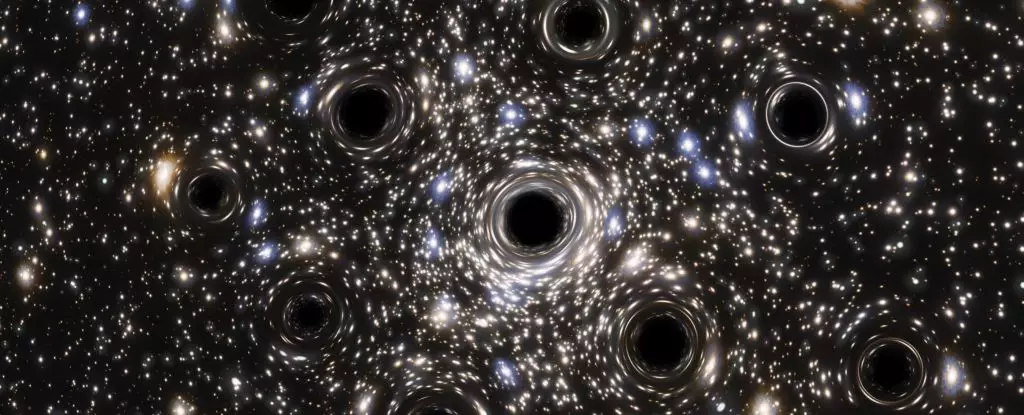The celestial landscape is rife with mysteries, but few are as compelling as the enigmas lurking within Omega Centauri, the largest globular star cluster in our Milky Way galaxy. Nestled approximately 17,000 light-years away, Omega Centauri is a densely packed conglomeration of stars that has captivated astronomers for decades. It has recently become the focus of attention due to emerging evidence suggesting the existence of multiple stellar-mass black holes within its core, challenging the long-held assumption of a singular, supermassive black hole at its center. This discovery opens new horizons for understanding not only Omega Centauri itself but also the broader cosmic architecture of our universe.
Historically, the prevailing theory regarding the mass at the heart of Omega Centauri proposed the existence of a singular black hole, with mass estimates reaching thousands of times that of the Sun. However, new findings have steered the narrative in a different direction. Astrophysicist Andrés Banares Hernández from the Institute of Astrophysics of the Canary Islands articulates a critical turning point in our understanding: “By investigating Omega Centauri, a remnant of a dwarf galaxy, we can ascertain the existence and implications of intermediate-mass black holes (IMBHs). This work not only addresses long-standing questions but also maps potential pathways for future explorations of black hole formation and interactions.”
This revised narrative suggests a dynamic ecosystem within Omega Centauri, where multiple stellar-mass black holes might coexist. Such a configuration would have profound implications for our comprehension of star cluster evolution and galaxy formation.
Omega Centauri is not merely a group of stars but is thought to be the remnant core of a dwarf galaxy, dubbed the Gaia Sausage, that was absorbed into the Milky Way eons ago. Dwarf galaxies, it appears, may represent miniature versions of their larger counterparts, lacking the supermassive black holes that anchor massive galaxies but potentially housing IMBHs instead. This tantalizing possibility resonates deeply within the astrophysics community, as finding evidence for IMBHs could unravel the complex web of relationships linking stellar-mass black holes with the supermassive giants that dominate galactic centers.
Yet, locating these elusive intermediate-mass black holes has proven incredibly challenging, predominantly because black holes do not emit light unless they are actively accreting material. Consequently, their presence can only be inferred through indirect evidence—an endeavor that necessitates meticulous and innovative astrophysical methods.
To venture deeper into Omega Centauri’s secrets, astronomers have employed pulsars, which are essentially rapid-rotating neutron stars emitting beams of electromagnetic radiation. The pulsating nature of these stars allows scientists to gauge their rotational periods and thereby obtain precise measurements of motion and acceleration in their vicinity. Leading a pivotal study, Banares Hernández and his team incorporated pulsar data into their analysis. Their findings supported the hypothesis of a concealed mass in Omega Centauri, positing it as the result of a crowd of stellar-mass black holes rather than a single central entity.
However, while this conclusion provides clarity, it leaves a tantalizing question lingering: Could both stellar-mass black holes and an IMBH coexist? Such a scenario could offer the answer to the complications of locating a singular IMBH. Specifically, if stellar-mass black holes are gravitationally bound, they might form an intricate system in which an IMBH exerts its influence, thus complicating the picture further.
The quest to unveil the nature of black holes continues unabated. The confirmation of a population of stellar-mass black holes within Omega Centauri could provide essential clues regarding the formation of larger black holes through a process of hierarchical mergers. The idea that IMBHs might form from the gravitational amalgamation of these smaller black holes introduces an additional layer of complexity to the search.
The astronomical community is poised at the brink of potentially groundbreaking discoveries, driven by innovative methodologies and the promise of emerging technologies. As Banares Hernández aptly notes, “The hunt for elusive intermediate-mass black holes continues,” signaling both optimism and anticipation in a field that thrives on inquiry and exploration.
The advancements made in understanding the nature of Omega Centauri and its potential inhabitants highlight the intricate and sometimes perplexing tapestry of our universe. Each discovery not only resolves existing uncertainties but also unravels further questions, compelling scientists to delve deeper. As the exploration of stellar-mass black holes and the quest for IMBHs progresses, we stand on the precipice of a more nuanced understanding of the cosmos, unlocking secrets that have remained hidden for eons. The implications of finding intermediate-mass black holes are profound, heralding a new chapter in astrophysics that promises to reshape our knowledge of the universe’s evolution and the rich diversity of phenomena within it.


Leave a Reply